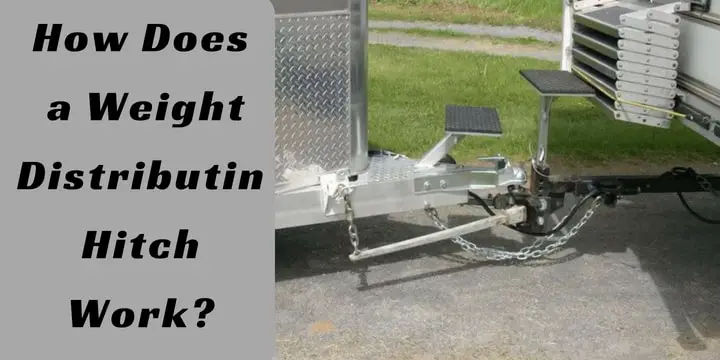How does a weight-distribution hitch work?
One worry that can be scary to drivers of trailers is a swaying vehicle that sends chills in their veins as they figure out how to survive the possibility of losing control over their vehicles. A weight distribution system is one of the best ways to clear such worries when pulling large loads. It helps to smoothly handle a bumper. The question that most drivers don’t ask themselves is how does a weight-distribution hitch work?
There are two key terms to familiarize with. The gross trailer weight (GTW) and tongue weight (TW). GTW is the weight of the cargo. TW is approximately 10 percent of the GTW pressing on the hitch inclusive of any other weight behind the rear axle.
If the TW us too much than the GTW, there is a possibility of the trailer swaying. Similarly, less TW compared to GTW can make the trailer to sway as it may swing because of lost control. Balancing the weight of the tongue and the gross trailer is very important.
Weight distribution hitches come in handy preventing the dangerous circumstances of a possibility of the trailer swaying. Sitting under the tongue of the trailer, weight distribution hitches help in transferring the TW from the bumper of the vehicle that is owing to two axles, it’s own and that of the trailer.
In a nutshell, the weight distribution hitch spreads the weight in a way to achieve balance and stability by preventing too much of the trailer’s weight from concentrating on the tongue. Distributed weight increases the stability of trailers preventing poor handling.
Controlling a trailer becomes much easier when weight is evenly distributed all over the trailer. Further, a balanced distribution of weight makes it possible to tow a load capacity that is close to the maximum capacity or weight that the trailer can hold. After the question of how does a weight distribution works’ let’s check out the installation process.
Video Overview: Weight Distribution Hitch Explained
> You may also like The Best Generator For Travel Trailers.<<
A step by step guide for installing a trailer sway bar
Make proper adjustments to the level of the trailer. Level the level of the trailer to achieve parallelism to the ground. Measure the front and rare wheel to get the level difference. Take good note of the measurements.
Install the shank by plugging it into the receiver. You may turn the shank downward or upward to make a level adjustment and ensure it fits properly.
Mount the assembly of the head ball to the shank. Spring bars and the hitch ball will hang here. You may now re-harness the towing vehicle and the trailer.
Use an appropriate tool to attach the hitch ball to the hitch head. Tightly fit the shack and hitch head using bolts and nuts. Properly adjust the hitch head to align its height in a way to maintain a higher level of the ball.
Let the level guide in changing the angle of the hitch head. Fit the spring bar (torsion bar) into the hitch head. Ensure the end of the torsion bar is facing the trailer. Slightly lower the end toward the ground. Use the right tools to tighten the bolts and the nuts. Connect and fasten all the components together.
Video Overview: How to install a sway control on a trailer
Does weight distribution hitch increase tow capacity?
Yes, you can increase the overall towing capacity of a vehicle using a weight-distribution hitch. The hitch can is known to handle the added load that you wish to tow. Adding a unique system of weight distribution helps vehicles to tow additional weight. Almost in all cases, the amount of additional weight that can be towed is not a fixed number and depends on the type of vehicle. It’s better to refer your vehicle’s manual for hitch specifications regarding the maximum gross trailer weight allowed to be towed by the vehicle using a weight-distribution hitch.
Video Overview: Weight distribution & load-leveling hitches for heavy towing (plus nuts) | Auto Expert John Cadogan
What does a weight distribution mean?
The apportioning of weight within vehicles is known as weight distribution. They are more commonly done in cars, trains, and airplanes. The typical representation of the weight distribution is in the form of x/y, where x refers to the %ge of weight in the front part of the vehicle, whereas y refers to %age of weight in the back. In vehicles that rely on gravity in some way or other, weight distribution is known to directly affect various vehicle characteristics, such as acceleration, handling, component life, and traction.
Video Overview: Towing a trailer can be dangerous with the wrong weight distribution
How do you determine a trailer’s tongue weight?
Determining the correct trailer’s tongue weight is vital to understand the components needed to safely haul your vehicle. There are various methods to get the exact reading of it, such as.
- Weigh Safe ball mount
- Tongue weight scale
- Bathroom scale
- Commercial-scale
One thing to be kept in mind is that if one wants to use the weight distribution system, then they should have an idea of the total weight of the items that will be carried in a rear side of their vehicle just after the rear axle. The reason this is important to know is that any weight located behind the rear axle directly affects the overall actions of the spring bars. You have to factor this weight in overall weight so that you can easily select the properly sized spring bars for your trailer and vehicle.
Video Overview: Figuring Out Trailer Tongue Weight
> You may also like: First Time Travel Trailer Owner Tips, Beginner’s Guide. <<
What are you supposed to do when your trailer sways?
There are several hitches present in the market that is known to control the sways. However, weight distribution hitch uses special kinds of parts so as to distribute the overall tongue weight of the vehicle equally among all axles, both trailer and tow vehicle.
Video Overview: Sway when towing an RV? Watch this!
Is trailer tongue weight included in the payload?
Yes, the tongue weight must be added in the tow vehicle’s payload capacity.
For example 1,000 pound trailer = 100 pounds tongue weight.
However, this additional weight should not exceed the total GVWR when added with the cargo and passengers already sitting inside.
For e.g., let’s take a hypothetical vehicle and its assumed 10000 pound GVWR offers around 4000 pounds of total payload capacity. Now, if you were to hitch up to that 6000-pound trailer, its 600 pounds of tongue weight would easily reduce that previous 4000-pound payload capacity to only 3500 pounds.
Video Overview: PAYLOAD PROBLEMS: HOW MUCH CAN I (REALLY) TOW? RV Truck & Trailer
What is the tongue weight of a trailer?
Tongue weight refers to the weight a trailer puts in a downward direction when it is fully loaded.
> You may also like:45 RV Accessory Must-Haves for Your Travel Trailer<<



